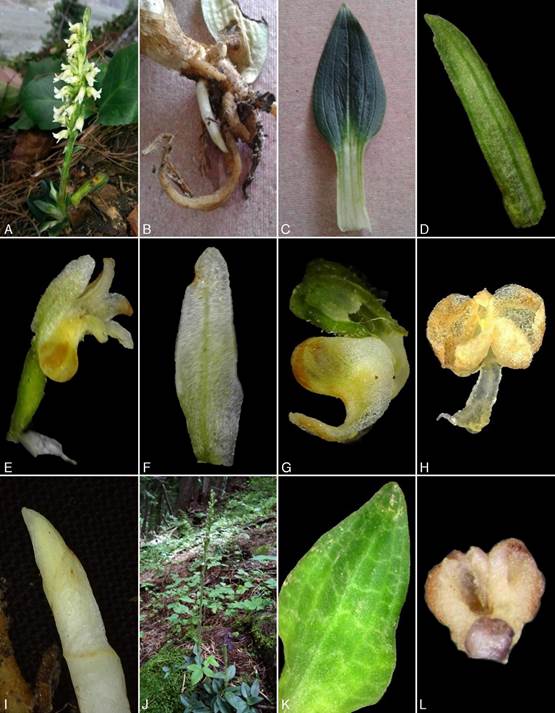Introduction
Orchidaceae is the second largest family of flowering plants with 870 genera and ca. 25,000 species, distributed worldwide (Swarts & Dixon 2009, Rao et al. 2012). Orchids are widely distributed in tropical, subtropical and temperate regions in all continents except Antarctica, but reach their maximum diversity in the humid tropical regions. The family constitutes 9% of the total Indian flora and is represented by 177 genera with ca. 1,195 species (Misra 2007, Singh et al. 2001). In India, the Himalayas represent one of the global biodiversity hotspots (Mittermeier et al. 2005), and are well-known to harbor a rich diversity of orchids (Vij & Pathak 2010, Jalal & Jayanthi 2015).
In the northwestern extreme of the Indian Himalayas, the Kashmir Himalaya constitutes a biodiversity-rich region (Dar & Khuroo 2013). From this region, 44 orchid species have been recorded (Duthie 1906, Naqshi et al. 1989, Akhter et al. 2011), including one species of the genus Goodyera, i.e. Grepens (L.) R.Br. (Kant & Chander 2004, Akhter et al. 2011). During recent botanical surveys in the Thajwas Wildlife Sanctuary, Sonamarg, Kashmir, the authors collected a hitherto unrecorded plant species from the region. After a detailed study of diagnostic characteristics of the fresh plant material and perusal of taxonomic literature, the species was identified as Goodyera fusca (Lindl.) Hook.f. which turned out to be a new record for the flora of Kashmir Himalaya. In order to validate this new record, the present paper provides a detailed taxonomic description, microphotographs of diagnostic characters (Figure 1) delimiting characters from its con-generic species occurring in this region (Table 1), which will facilitate its field identification.
Materials and Methods
Standard taxonomic methods have been used for collection, drying, and further processing of the herbarium specimens (Bridson & Forman 1998) deposited in the Kashmir University Herbarium (KASH) with a proper voucher specimen number. The fresh plant specimens have been identified using relevant taxonomic literature (Hooker 1897, Stewart 1972, Duthie 1906, King & Pantling 1979, Deva & Nathani 1986). The photographs of the diagnostic characters were taken with Handheld Portable microscope (Make: DINO Lite AM4515ZT4).
Taxonomic treatment
Goodyera fusca (Lindl). Hook. f. Fl. Brit. India 6: 112, 1890.
Bas.: Hetaeria fusca Lindl. Syn.: Cystorchis fusca (Lindl.) Benth. & Hook. f.; Epipactis fusca (Lindl.) A.A.Eaton, Orchiodes fusca (Lindl.) Kuntze.

Figure 1 Goodyera fusca (Lindl.) Hook.f. A. Habit. B. Rootstock. C. Leaf. D. Bract. E. Flower. F. Sepal. G. Labellum. Pollinia. I. Tuber. J. G. repens (L.) R.Br. K. Surface of leaf of G. repens. L. Pollinia of G. repens. (Photo credits: Anzar A. Khuroo, Gowhar A. Shapoo, Shugufta Rasheed, and Shah Rafiq)
Table 1 Comparison of diagnostic characters between G. repens and G. fusca occurring in the Jammu and Kashmir, India.
| Diagnostic characters | G. repens | G. fusca |
|---|---|---|
| Leaf | Whitish green, marbled | Thick, fleshy, 5-nerved |
| Petiole | Sheathing in lower half | Sheathing at the base |
| Bracts | Linear-lanceolate | Ovate-oblong |
| Petals | Lanceolate, adhering on the inner margins to the dorsal sepal | Sigmoid, linear-oblong, sub-acute |
| Lip/Labellum | Sac of the lip papillose without any ridges inside | Sac of the lip glabrous with two ridges inside |
Terrestrial leafy herb, height 16 cm. Stem glabrous, 8 cm long. Leaves clustered near the base, thick ovate, 4 cm long, 5-nerved, margins revolute, petiole 6 mm broad. Bracts leaf-like, oblong, 6 mm long. Inflorescence a many-flowered raceme, longer than the stem, 5.5 cm long. Flowers 5 mm long, pubescent, white flushed green. Sepals sub-equal, oblong, sub- acute, 4.4 mm. Petals linear, 5.15 mm long, oblong sigmoid, subacute. Labellum (lip) as long as sepals, deeply sub-globose at the base, sac of the lip with two ridges, glabrous inside, base conspicuously projecting beyond the base of the sepals. Column 1.5 mm long. Pollinia 2, broadly ovoid.
Specimen exAmined. India. Kashmir: District Ganderbal, Thajwas Wildlife Sanctuary, Sonamarg, 23-08-2017, Khuroo and Shapoo 0157 (KASH).
Habitat: Grows on open mountain slopes, in rock crevices with a dense layer of decomposed humus in the alpine zone at an elevation of 3700 m.
Phenology: Flowering was recorded in August- September.
Global distribution: China, Myanmar, Bhutan, Nepal, India (Arunachal Pradesh to Himachal Pradesh); and now extended further westwards to Kashmir Himalaya.












 uBio
uBio 

